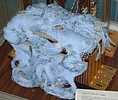Since then I have added material occasionally.
Items are certainly not complete, and may be inaccurate.
Your information, comments, corrections, etc. are eagerly requested.
Send e-mail to Ed Thelen. Please include the URL under discussion. Thank you ***
| Manufacturer | Cray Computer |
| Identification,ID | CRAY-3 CPU |
| Date of first manufacture | 1995 |
| Number produced | - |
| Estimated price or cost | - |
| location in museum | - |
| donor | - |
Contents of this page:
- Photo
- Placard
- Architecture
- Special Features
- Historical Notes
- This Artifact
- Interesting Web Sites
- Other information
 Cray-3 CPU Cray-3 CPU
|
| - |
| ?Similar to Cray 2? - ?binary compatable with Cray 1? |
|
Historical Notes
|
Number built
NCAR press release |
This Artifact
|
It's sleek, it's gray, it's a four-foot-tall postmodern cabinet. Through a clear
acrylic case on top, interconnect wires can be seen waving like kelp in a sea current. The
current is made of liquid coolant, which dissipates integrated-circuit heat; the computer
is the world's first CRAY-3, designed by Seymour Cray and installed at NCAR in May.
In his talk "Introduction to the CRAY-3," Ron Larson of Cray Computer Corporation (CCC) used slides to show the manufacturing process for the electronic modules that make up the core of the CRAY-3. Unlike conventional supercomputers, the CRAY-3 uses gallium arsenide (GaAs) for its logic circuits. CCC fabrication plants in Colorado Springs produce these logic circuits, as well as the printed circuit boards that go into the machine. During the production process, ultrasonic die bonders attach gold leads (tiny wire legs) to GaAs integrated circuit die. The leads of the die are then inserted through tiny holes in a one-inch-square printed circuit board and crushed, in a process that joins together die and boards. Sixteen die go on a board. Sixty-four boards, arranged in 16 stacks that are sandwiched around a set of four-inch-square plates, form a module; this packaging produces a logic density of 100 gates per cubic inch. Four modules comprise a processor. There are four processors in the CRAY-3 at NCAR. Old and new computational tools: pencil and CRAY-3 module. (Photo courtesy Cray Computer Corporation.) In addition to its processor modules, NCAR's CRAY-3 has 64 memory modules and 4 input/output modules. All these modules have a combined volume of 405 cubic inches and burn 88 kilowatts of power. "Eighty-eight kilowatts is a lot of energy to dissipate," Ron said, noting that the machine is filled with cooled Fluorinert that is pumped right through the component modules. "Now you know why Seymour is as good at refrigeration design as he is at computer logic." The computer's two-nanosecond clock represents a tremendous advance in miniaturization and speed since the CRAY-1 hit the market in 1976--but it's only a preview of things to come. "I saw a quote from Seymour last week," Ron said, quoting the legendary inventor: "'As long as we can make them smaller, we can make them faster.'" |
|
Other information
From
http://netlib2.cs.utk.edu/benchmark/top500/reports/report94/Architec/node6.html
The Cray Computer Corporation Cray-3
Machine type: Shared-memory multi-vectorprocessor.
System parameters:
Cray Computer Corporation (CCC) has been established by Seymour Cray to build the Cray-3, of which the first stages were done under the wings of the mother company, Cray Research Inc. It was decided that it was too much of a burden to develop two independent high-end product lines, the Cray Y-MP and the Cray-3. So, CCC split off and took then available Cray-2 with it as a marketable product. As might be expected the Cray-3 is reminiscent to the Cray-2. There are notable differences however: As in the Cray-2 there is a foreground processor which performs system tasks, I/O handling, and synchronisation of the background processors, the vectorprocessors proper. The maximum number of processors has grown from 4 to 16 in the Cray-3 and clock cycle is halved from 4 to 2 ns. The Cray-3 relies heavily on the use of GaAs components (CCC is with Convex the only company who actually uses these) to be able to condense the components to such an extent that the required clock cycle speed can be sustained.
|
If you have comments or suggestions, Send e-mail to Ed Thelen
Go to Antique Computer home page
Go to Visual Storage page
Go to top
Updated Dec, 2016